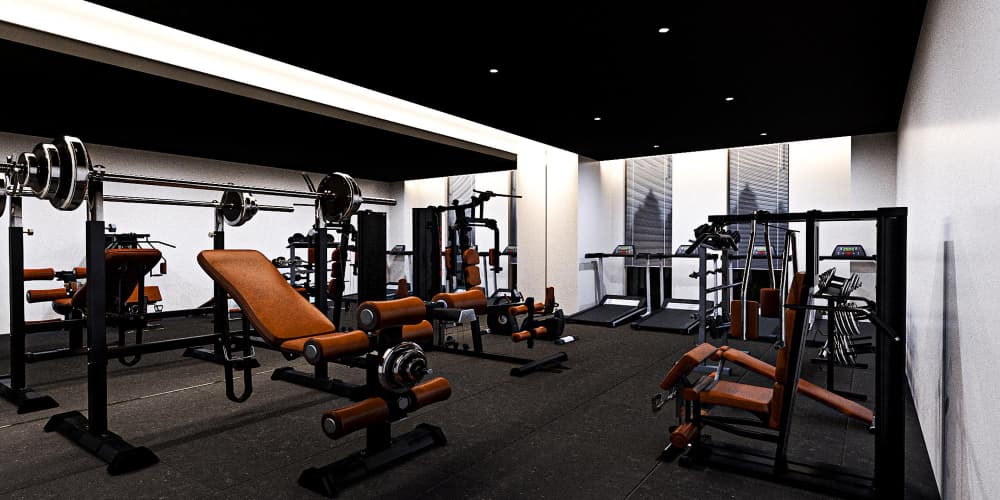Lateral Raise Machine: The Complete Guide to Stronger Shoulders

MyFitnessCoach
September 16, 2025
If you want wide, well-defined shoulders, the lateral raise machine is one of the most effective tools you can use. While dumbbell lateral raises are a popular choice, using a machine provides more stability, helps you isolate the medial deltoids, and reduces the risk of form breakdown. Whether you are a beginner or an experienced lifter, the lateral raise machine can help you develop round shoulders and improve overall upper body aesthetics.
In this article, we will cover the benefits, muscles worked, variations, mistakes to avoid, and how the MyFitnessCoach App can guide you in tracking progress and building complete shoulder workouts.
Muscles Worked by the Lateral Raise Machine
The primary muscle targeted is the medial deltoid, which is responsible for shoulder abduction (lifting your arms out to the sides). However, other muscles are engaged to support the movement, including:
- Anterior deltoid (front shoulder)
- Posterior deltoid (rear shoulder)
- Trapezius (upper back)
- Supraspinatus (rotator cuff muscle that initiates arm lift)
By isolating the lateral deltoid, the machine helps you achieve that "capped shoulder" look, enhancing the V-taper physique many strive for.
Benefits of Using the Lateral Raise Machine
1. Strict Muscle Isolation
Because the machine stabilizes your movement, it reduces momentum and forces your shoulders to do all the work. This isolation is ideal for building size and definition.
2. Safer for Beginners
For people new to weightlifting, using dumbbells can sometimes result in poor form or overuse of traps. The machine provides guidance, making it safer and easier to learn proper shoulder activation.
3. Consistent Resistance
Unlike dumbbells, where tension drops at the top of the lift due to gravity, the machine maintains resistance throughout the entire range of motion. This means your delts are under constant tension, leading to better muscle growth.
4. Great for Progressive Overload
The weight stack allows for small, controlled increases in resistance, making it easy to apply progressive overload without risking form breakdown.
5. Injury Prevention and Rehab Use
Since the machine offers stability, it’s often used in prehab and rehab workouts to strengthen the shoulders without placing too much stress on joints.
How to Perform the Lateral Raise Machine Correctly
- Adjust the seat height so that the machine’s pads or handles are aligned with your elbows.
- Sit upright with your back against the pad and grip the handles or place your elbows against the pads.
- Start with your arms down at your sides.
- Exhale and lift your arms outward and upward until they are parallel to the floor.
- Pause briefly at the top to squeeze your delts.
- Lower slowly back to the starting position under control.
Perform 3–4 sets of 10–15 reps depending on whether your goal is strength, hypertrophy, or endurance.
Common Mistakes to Avoid
- Shrugging Shoulders – Engaging traps too much takes tension away from the delts. Keep your shoulders relaxed.
- Using Too Much Weight – Going too heavy leads to poor form and momentum. Focus on lighter, controlled movements.
- Partial Range of Motion – Avoid lifting too low or too high; arms should move from your sides up to parallel with the ground.
- Fast Repetitions – Speed reduces time under tension. Slow, controlled reps maximize effectiveness.
- Leaning Forward or Backward – Stay upright to maintain proper isolation of the lateral delts.
Variations of the Lateral Raise Machine
- One-Arm Lateral Raise Machine – Train one side at a time for better mind-muscle connection.
- Partial Reps – Focus on the top half of the lift to maximize constant tension.
- Drop Sets – Reduce the weight immediately after reaching failure for more volume and intensity.
- Tempo Training – Extend the lowering phase to increase time under tension.
Lateral Raise Machine vs Dumbbell Lateral Raises
Both exercises target the same muscle, but they have differences:
- Machine: Provides stability, constant tension, and is easier for beginners.
- Dumbbells: Require balance, engage stabilizers, and allow more natural movement.
For best results, include both in your shoulder workout routine.
Integrating the Lateral Raise Machine into a Shoulder Workout
Here’s an example of a shoulder routine:
- Overhead Press – 4 sets of 8–10 reps
- Dumbbell Lateral Raise – 3 sets of 12–15 reps
- Lateral Raise Machine – 3 sets of 12–15 reps
- Face Pulls – 3 sets of 12–15 reps
- Rear Delt Flyes – 3 sets of 12–15 reps
This combination ensures all three heads of the deltoid are targeted.
Track Your Shoulder Workouts with MyFitnessCoach
Building strong shoulders requires more than just good workouts; it requires consistency, tracking, and progression. That’s where the MyFitnessCoach App comes in.
With the Workout Logger feature, you can log your sets, reps, and weights every time you use the lateral raise machine. The app also provides AI-powered fitness insights, suggesting when to increase weight, how to balance your workout, and what nutrition adjustments can support shoulder growth.
You can even combine your shoulder workouts with diet plans, macro tracking, and recovery tips, all inside the app, making your training smarter and more efficient.
Final Thoughts
The lateral raise machine is one of the best tools to build stronger, wider, and more defined shoulders. Its ability to isolate the lateral delts, provide constant tension, and reduce injury risk makes it a must-have in your workout plan.
To maximize your progress, track your machine workouts with the MyFitnessCoach App. With features like a Workout Logger, AI fitness insights, and customized diet plans, you can ensure your shoulder workouts are effective and aligned with your fitness goals.
Download MyFitnessCoach today and take your shoulder training to the next level.

Similar Articles
Stay informed with these similar articles.

MyFitnessCoach
May 9, 2025
What Sweaty Kneecaps Means and 5 Tips to Prevent It?
Ever noticed your knees getting sweaty for no reason? You’re not alone. Sweaty kneecaps might seem odd, but they’re more common than you think.

MyFitnessCoach
March 6, 2025
Arm Swing Exercise: Effective Way to Boost Your Fitness
When it comes to fitness, we often think of intense workouts, heavy lifting, or long runs. But what if I told you that a simple exercise like arm swings could be just as effective in improving your overall fitness? Arm swing exercises are easy to do, require no equipment, and can be done anywhere. Whether you're a beginner or a fitness enthusiast, arm swings can help you improve flexibility, strength, and even cardiovascular health. In this article, we’ll explore the benefits of arm swing exercises, how to do them correctly, and how you can incorporate them into your fitness routine using the MyFitnessCoach app.

MyFitnessCoach
February 24, 2025
Best Deodorant for Athletes: Stay Fresh During Your Workouts
When you're an athlete or someone who loves to stay active, staying fresh and odor-free is a top priority. Whether you're hitting the gym, running a marathon, or sweating it out during a high-intensity workout, the right deodorant can make all the difference. But with so many options available, how do you choose the best deodorant for athletes? In this article, we’ll break down everything you need to know about finding the perfect deodorant to keep you feeling confident and fresh, no matter how intense your workout gets. Plus, we’ll show you how the MyFitnessCoach app can help you stay on top of your fitness game.
